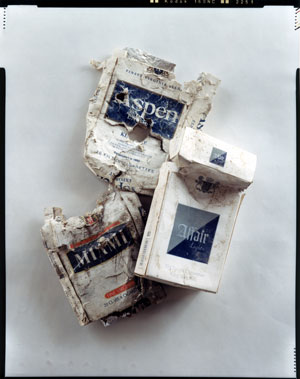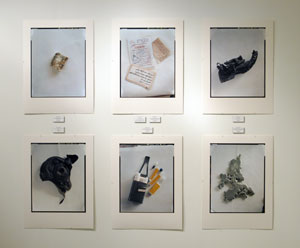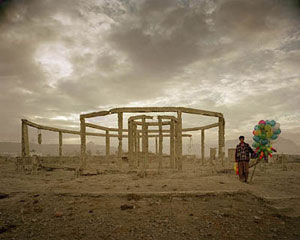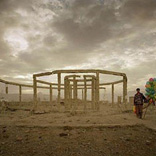What is more disquieting: fear of the known, or fear of the unknown? Unfortunately, the people who can answer such a question with any authority are rarely amongst the living.

Simon Norfolk, Baghdad Fragments:Cigarettes of Iraqi troops with American-style brand names; found in various places.... Baghdad, 18-27 April 2003; 19.5" x 24"; Type C print
There is a class of people — soldiers, field surgeons, war correspondents and photojournalists — whose exposure to battle gives them experience with visceral fear of the known and unknown. But these people often grow so desensitized to the macabre, post-apocalyptic visage of the battlefield that their observations on the subject cease to be suitably revelatory to a general audience.
Like many former photojournalists, London-based Simon Norfolk is no stranger to the hellholes of war on this planet. His current photographs, however, judiciously avoid documenting violence in action. Instead he hints at recent brutalities, allowing an intellective space for the audience to project their own moral conclusions, and ultimately revealing his consciousness of the fact that to most, war is an unfathomable abstraction. Two of Norfolk’s most recent series are on display at Blue Star Contemporary Art Center in San Antonio. Afghanistan: Chronotopia (2001-2002) records the tidal ebb and flow of violence across the endless Afghani wasteland, while Baghdad Fragments (2003) depicts discarded personal possessions discovered after the recent fall of Baghdad.
Norfolk shot Afghanistan: Chronotopia with a bulky, archaic field camera, giving many of the images the epic sweep and tonal quality of a mid-century spaghetti Western. The framing of these spacious, highly detailed landscapes mimic iconic photos of archeological marvels, each balancing the brilliance of nature with deteriorating man-made structures. But in a postcard of the Parthenon against a Technicolor sky, the crumbling edifice is somehow ennobled by the gentle passage of time. Such images communicate the fragility of this messy human experiment called civilization — theme central to European art since the Renaissance. But Norfolk’s images reveal not the long-term effects of time, but the very tangible, cataclysmic, and technologically-rooted impact of modern man upon the recumbent Afghani landscape. They communicate an aberrant, forced mortality born of bullet holes and bunker bombs, completely devoid of the romantic sentimentality of civilizations past. Jet contrails scrape the evening sky, ruining the otherwise picturesque strokes of a stunning desert sunset; a shell-shocked balloon seller stands at carnivalesque sentry to the shell of a Kabul teahouse — the reality of war is etched upon each of Norfolk’s images.
Baghdad Fragments is a more naked and visceral project than Chronotopia. In each related tableau, objects discovered by the artist after the fall of Baghdad are arranged with forensic specificity atop a clean white surface and dutifully photographed like evidence from a crime scene. In a few of Norfolk’s large prints, the edge of a desk is clearly visible. This seemingly harried and slightly haphazard methodology adds an uncomfortable sense of urgency to the work, as if the artist himself was literally working under the gun. Given that all of these images were taken between April 18th and 27th 2003 — just days after Baghdad fell — this might actually have been the case.
Such banal objects as teakettles and toiletries become ominous funerary artifacts, imbibed with unseen panic, hopelessness, and deadly uncertainty. They hang between intricately detailed photographs of charred army boots, blistered ID cards, and spent American-made cannon shells, grenades, bullet casings, and bomb fragments. Again, the artist relies on idiosyncratic association, forcing the audience to draw a conclusion from the combination of cultural relics set before them. All politics aside, the conclusions are inevitable: it is astounding that such clinical images can communicate panic, fear, and certain doom so clearly, despite the conspicuous absence of tender human flesh.
Images courtesy the artist and Blue Star Art Space.
Anjali Gupta is a writer living in San Antonio.





